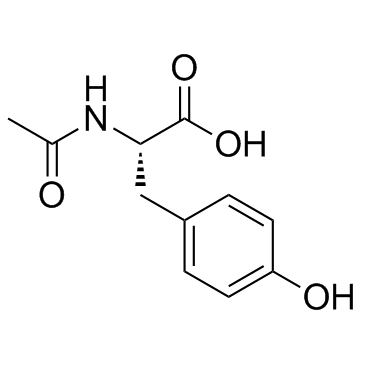N-乙酰-L-酪氨酸

N-乙酰-L-酪氨酸结构式

|
常用名 | N-乙酰-L-酪氨酸 | 英文名 | N-Acetyl-L-tyrosine |
|---|---|---|---|---|
| CAS号 | 537-55-3 | 分子量 | 223.225 | |
| 密度 | 1.3±0.1 g/cm3 | 沸点 | 531.3±45.0 °C at 760 mmHg | |
| 分子式 | C11H13NO4 | 熔点 | 149-152 °C(lit.) | |
| MSDS | 中文版 美版 | 闪点 | 275.1±28.7 °C | |
| 符号 |

GHS05 |
信号词 | Danger |
|
Surfactants, aromatic and isoprenoid compounds, and fatty acid biosynthesis inhibitors suppress Staphylococcus aureus production of toxic shock syndrome toxin 1.
Antimicrob. Agents Chemother. 53 , 1898-906, (2009) Menstrual toxic shock syndrome is a rare but potentially life-threatening illness manifest through the actions of Staphylococcus aureus toxic shock syndrome toxin 1 (TSST-1). Previous studies have shown that tampon additives can influence staphylococcal TSST-... |
|
|
Detection of autosomal dominant polycystic kidney disease by NMR spectroscopic fingerprinting of urine.
Kidney Int. 79(11) , 1244-53, (2011) Autosomal dominant polycystic kidney disease (ADPKD) is a frequent cause of kidney failure; however, urinary biomarkers for the disease are lacking. In a step towards identifying such markers, we used multidimensional-multinuclear nuclear magnetic resonance (... |
|
|
Newborn screening for congenital adrenal hyperplasia: additional steroid profile using liquid chromatography-tandem mass spectrometry.
J. Clin. Endocrinol. Metab. 92(7) , 2581-9, (2007) Neonatal screening programs for congenital adrenal hyperplasia (21-CAH) using an immunoassay for 17alpha-hydroxyprogesterone (17-OHP) generate a high rate of positive results attributable to physiological reasons and to cross-reactions with steroids other tha... |
|
|
Utilization of tyrosine-containing dipeptides and N-acetyl-tyrosine in hepatic failure.
Hepatology 21(4) , 923-8, (1995) The impact of hepatic dysfunction on the elimination and hydrolysis of three potential tyrosine sources for total parenteral nutrition, the dipeptides L-alanyl-L-tyrosine (Ala-Tyr) and glycyl-L-tyrosine (Gly-Tyr), and N-acetyl-L-tyrosine (Nac-Tyr) were evalua... |
|
|
Influence of alkyl group on amide nitrogen atom on fluorescence quenching of tyrosine amide and N-acetyltyrosine amide.
Biophys. Chem. 111(2) , 105-13, (2004) The steady-state and time-resolved fluorescence spectroscopy was applied to determine the influence of an alkyl substituent(s) (methyl or ethyl, n-propyl, iso-propyl, n-butyl, sec-butyl, or t-butyl) on amide nitrogen atom on photophysical properties of tyrosi... |
|
|
N-Glycans protect proteins from protease digestion through their binding affinities for aromatic amino acid residues.
J. Biochem. 127(3) , 427-33, (2000) It was previously revealed [Yamaguchi, H., Nishiyama, T., and Uchida, M. (1999) J. Biochem. 126, 261-265] that N-glycans of both the high-mannose and complex types have binding affinity for aromatic amino acid residues. This study shows that free N-glycans pr... |
|
|
Chlorination of N-acetyltyrosine with HOCl, chloramines, and myeloperoxidase-hydrogen peroxide-chloride system.
Acta Biochim. Pol. 48(1) , 271-5, (2001) N-acetyl-L-tyrosine (N-acTyr), with the alpha amine residue blocked by acetylation, can mimic the reactivity of exposed tyrosyl residues incorporated into polypeptides. In this study chlorination of N-acTyr residue at positions 3 and 5 in reactions with NaOCl... |
|
|
Estimation of serum alpha 2-macroglobulin based on the esterolytic activity of bound alpha-chymotrypsin.
Biochem. Med. 32(3) , 357-63, (1984) A colorimetric method to estimate alpha 2-macroglobulin (MG) in human serum is described which is based on the capacity of MG:alpha-chymotrypsin complex to hydrolyze N-acetyl L-tyrosine ethyl ester in the presence of excess crude preparation of a trypsin/chym... |
|
|
Effect of 3-hydroxyanthranilic acid on mushroom tyrosinase activity.
Biochim. Biophys. Acta 1384(2) , 268-76, (1998) Tyrosinase is a copper containing protein which catalyzes the hydroxylation of monophenols and the oxidation of diphenols to o-quinones. The monophenolase activity of tyrosinase is characterized by a typical lag time. In this paper the influence of 3-hydroxya... |
|
|
N-acetyl tyrosyluria caused by parenteral or enteral administration of N-acetyl-L-tyrosine: differentiation from hereditary and acquired tyrosinemias.
J. Pediatr. Gastroenterol. Nutr. 39(1) , 95-100, (2004)
|